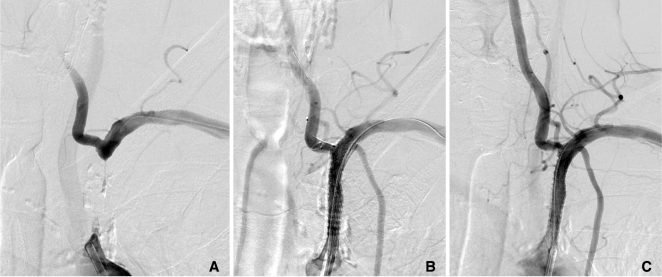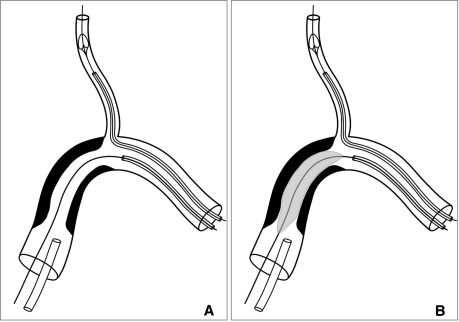Neurointervention.
2011 Aug;6(2):89-94. 10.5469/neuroint.2011.6.2.89.
The Use of Protection Device in Landmark-wire Technique of Symptomatic Subclavian Artery Occlusion with Combined Approach via Trans-femoral vs. Trans-brachial Arteries: Technical note
- Affiliations
-
- 1Department of Radiology and Research Institute of Radiology, University of Ulsan, College of Medicine, Asan Medical Center, Seoul, Korea. dcsuh@amc.seoul.kr
- 2Department of Diagnostic Radiology, Ajou University School of Medicine, Yeongtong-gu, Suwon, Korea.
- 3Department of Neurology, University of Ulsan, College of Medicine, Asan Medical Center, Seoul, Korea.
- KMID: 1783989
- DOI: http://doi.org/10.5469/neuroint.2011.6.2.89
Abstract
- PURPOSE
Since we reported about a landmark technique to reopen an occluded subclavian artery, we have faced difficulty in using protection devices in the vertebral artery to protect against thromboembolism from the reversed steal phenomenon after angioplasty and stenting. Therefore, we are presenting an optimal solution in using a protection device while recanalizing the occluded subclavian artery.
MATERIALS AND METHODS
Among 21 cases of stenting for subclavian artery steno-occlusion, we applied the landmark technique at the opposite end of an occluded segment in 4 patients and used a protection device in two patients. Because the embolic protection device was placed in the vertebral artery via the brachial artery, optimal angioplasty and stenting via the brachial route were limited. Therefore, angioplasty via the trans-brachial approach was needed to be followed by stenting through a trans-femoral approach. We estimated the safe and optimal steps for placement and retrieval of the protection devices in addition to stenting.
RESULTS
The procedure was safely performed when a stent was introduced via the femoral artery and a protection device was used via the brachial artery. However, in cases when a guidewire wasn't passed via the transfemoral route, simultaneous use of two systems via the brachial route could cause friction of devices or trapping of protection devices in a stent. When a protection device was trapped in a deployed stent, we retrieved the protection device with a 4F angiocatheter by selectively rotating the catheter tip. To avoid such procedural difficulty, we recommend using a transbrachial angioplasty followed by trans-femoral stenting while placing the protection device in the vertebral artery via the trans-brachial route.
CONCLUSION
If a guidewire is not passed through using a trans-femoral approach while performing the landmark technique, changing the stenting route from brachial to the femoral artery can be useful after securing the lumen in the occluded subclavian artery after angioplasty via the brachial artery.
MeSH Terms
Figure
Cited by 1 articles
-
Feasibility of the Transradial or the Transbrachial Approach in Various Neurointerventional Procedures
Dong Geun Lee, Deok Hee Lee, Jae Ho Shim, Dae Chul Suh
Neurointervention. 2015;10(2):74-81. doi: 10.5469/neuroint.2015.10.2.74.
Reference
-
1. Suh DC, Lee SH, Kim KR, Park ST, Lim SM, Kim SJ, et al. Pattern of atherosclerotic carotid stenosis in Korean patients with stroke: different involvement of intracranial versus extracranial vessels. AJNR Am J Neuroradiol. 2003; 24:239–244. PMID: 12591640.2. Suh DC, Ko YB, Park ST, Yoon KH, Lim OK, Oh JS, et al. Computational flow dynamics of the severe M1 stenosis before and after stenting. Neurointervention. 2011; 6:13–16.
Article3. In HS, Lee HY, Park JY, Kim SY, Jung JH, Kim JS, et al. Intracranial stenting in patients with atherosclerotic stenosis associated with various aneurysms in the same diseased arterial segment. AJNR Am J Neuroradiol. 2010; 31:1895–1898. PMID: 20671060.
Article4. Choi JW, Kim JK, Choi BS, Lim HK, Kim SJ, Kim JS, et al. Angiographic pattern of symptomatic severe M1 stenosis: comparison with presenting symptoms, infarct patterns, perfusion status, and outcome after recanalization. Cerebrovasc Dis. 2010; 29:297–303. PMID: 20090322.
Article5. Choi BS, Park JW, Shin JE, Lu PH, Kim JK, Kim SJ, et al. Outcome evaluation of carotid stenting in high-risk patients with symptomatic carotid near occlusion. Interv Neuroradiol. 2010; 16:309–316. PMID: 20977866.
Article6. Suh DC, Kim JK, Choi JW, Choi BS, Pyun HW, Choi YJ, et al. Intracranial stenting of severe symptomatic intracranial stenosis: results of 100 consecutive patients. AJNR Am J Neuroradiol. 2008; 29:781–785. PMID: 18310234.
Article7. Gonzalez A, Gil-Peralta A, Gonzalez-Marcos JR, Mayol A. Angioplasty and stenting for total symptomatic atherosclerotic occlusion of the subclavian or innominate arteries. Cerebrovasc Dis. 2002; 13:107–113. PMID: 11867884.
Article8. Pyun HW, Suh DC, Kim JK, Kim JS, Choi YJ, Kim MH, et al. Concomitant multiple revascularizations in supra-aortic arteries: short-term results in 50 patients. AJNR Am J Neuroradiol. 2007; 28:1895–1901. PMID: 17921235.
Article9. Liu S, Hee Jung J, Kwon HJ, Kim SM, Suh DC. Landmark-wire technique of symptomatic subclavian artery occlusion. Interv Neuroradiol. 2009; 15:401–405. PMID: 20465876.
Article10. Park ST, Kim JK, Yoon KH, Park SO, Park SW, Kim JS, et al. Atherosclerotic carotid stenoses of apical versus body lesions in high-risk carotid stenting patients. AJNR Am J Neuroradiol. 2010; 31:1106–1112. PMID: 20093309.
Article11. Liu S, Jung JH, Kim SM, Lim HK, Kwon HJ, Kim JK, et al. Simultaneous bilateral carotid stenting in high-risk patients. AJNR Am J Neuroradiol. 2010; 31:1113–1117. PMID: 20053810.
Article12. Kim HJ, Choi BS, Choi JW, Kim SJ, Lee HY, Suh DC. Stent implantation of multichanneled pseudoocclusion of the internal carotid artery. J Vasc Interv Radiol. 2009; 20:391–395. PMID: 19167242.
Article13. Taylor DW, Barnett HJ, Haynes RB, Ferguson GG, Sackett DL, Thorpe KE, et al. ASA and Carotid Endarterectomy (ACE) Trial Collaborators. Low-dose and high-dose acetylsalicylic acid for patients undergoing carotid endarterectomy: a randomised controlled trial. Lancet. 1999; 353:2179–2184. PMID: 10392981.
Article14. Suh DC, Kim JK, Choi CG, Kim SJ, Pyun HW, Ahn C, et al. Prognostic factors for neurologic outcome after endovascular revascularization of acute symptomatic occlusion of the internal carotid artery. AJNR Am J Neuroradiol. 2007; 28:1167–1171. PMID: 17569981.
Article15. Schillinger M, Haumer M, Schillinger S, Mlekusch W, Ahmadi R, Minar E. Outcome of conservative versus interventional treatment of subclavian artery stenosis. J Endovasc Ther. 2002; 9:139–146. PMID: 12010091.
Article16. Duber C, Klose KJ, Kopp H, Schmiedt W. Percutaneous transluminal angioplasty for occlusion of the subclavian artery: short- and long-term results. Cardiovasc Intervent Radiol. 1992; 15:205–210. PMID: 1394355.17. Sharma S, Kaul U, Rajani M. Identifying high-risk patients for percutaneous transluminal angioplasty of subclavian and innominate arteries. Acta Radiol. 1991; 32:381–385. PMID: 1832919.
Article18. Martinez R, Rodriguez-Lopez J, Torruella L, Ray L, Lopez-Galarza L, Diethrich EB. Stenting for occlusion of the subclavian arteries. Technical aspects and follow-up results. Tex Heart Inst J. 1997; 24:23–27. PMID: 9068135.19. Amor M, Eid-Lidt G, Chati Z, Wilentz JR. Endovascular treatment of the subclavian artery: stent implantation with or without predilatation. Catheter Cardiovasc Interv. 2004; 63:364–370. PMID: 15505851.
Article20. Mathias KD, Luth I, Haarmann P. Percutaneous transluminal angioplasty of proximal subclavian artery occlusions. Cardiovasc Intervent Radiol. 1993; 16:214–218. PMID: 8402782.
Article21. Domenig CM, Linni K, Mader N, Kretschmer G, Magometschnigg H, Holzenbein TJ. Subclavian to carotid artery transposition: medial versus lateral approach. Eur J Vasc Endovasc Surg. 2008; 35:551–557. PMID: 18258460.
Article22. Schillinger M, Haumer M, Schillinger S, Ahmadi R, Minar E. Risk stratification for subclavian artery angioplasty: is there an increased rate of restenosis after stent implantation? J Endovasc Ther. 2001; 8:550–557. PMID: 11797967.
Article23. Ringelstein EB, Zeumer H. Delayed reversal of vertebral artery blood flow following percutaneous transluminal angioplasty for subclavian steal syndrome. Neuroradiology. 1984; 26:189–198. PMID: 6234477.
Article24. McNamara TO, Greaser LE, Fischer JR, Gobin YP, Duckwiler G. Initial and long-term results of treatment of brachiocephalic arterial stenoses and occlusions with balloon angioplasty, thrombolysis, stents. J Invasive Cardiol. 1997; 9:372–383. PMID: 10762929.25. Becker GJ, Katzen BT, Dake MD. Noncoronary angioplasty. Radiology. 1989; 170:921–940. PMID: 2521745.
Article26. Angle JF, Matsumoto AH, McGraw JK, Spinosa DJ, Hagspiel KD, Leung DA, et al. Percutaneous angioplasty and stenting of left subclavian artery stenosis in patients with left internal mammary-coronary bypass grafts: clinical experience and long-term follow-up. Vasc Endovascular Surg. 2003; 37:89–97. PMID: 12669139.
Article27. Wholey MH, Wholey M, Mathias K, Roubin GS, Diethrich EB, Henry M, et al. Global experience in cervical carotid artery stent placement. Catheter Cardiovasc Interv. 2000; 50:160–167. PMID: 10842380.
Article
- Full Text Links
- Actions
-
Cited
- CITED
-
- Close
- Share
- Similar articles
-
- Direct Brachial Approach for Acute Basilar Artery Occlusion: Technical Note and Preliminary Clinical Experience
- Endovascular Stenting under Cardiac and Cerebral Protection for Subclavian Steal after Coronary Artery Bypass Grafting Due to Right Subclavian Artery Origin Stenosis
- Trans-sphenoidal Approach to the Supraclinoid Internal Carotid Artery for Endovascular Access in a Cadaver
- Trans-Inferior Turbinate Approach for Endoscopic Sphenopalatine Artery Ligation
- A Dual (Brachial and Contralateral Femoral) Approach for Subintimal Angioplasty of Long Ilio-Femoral Occlusive Disease Including the Iliac Ostium



